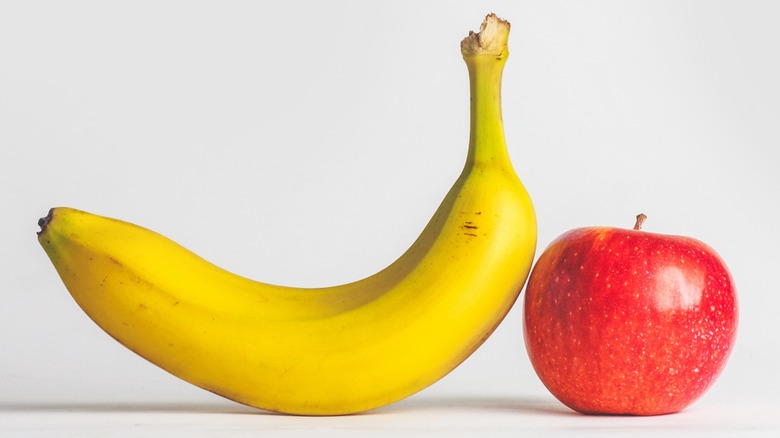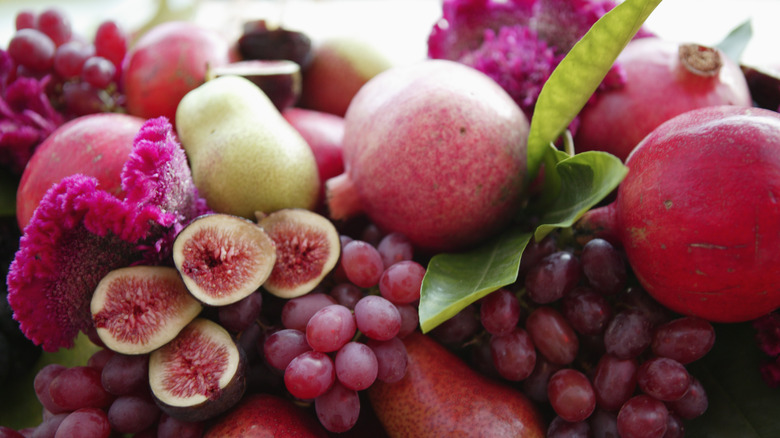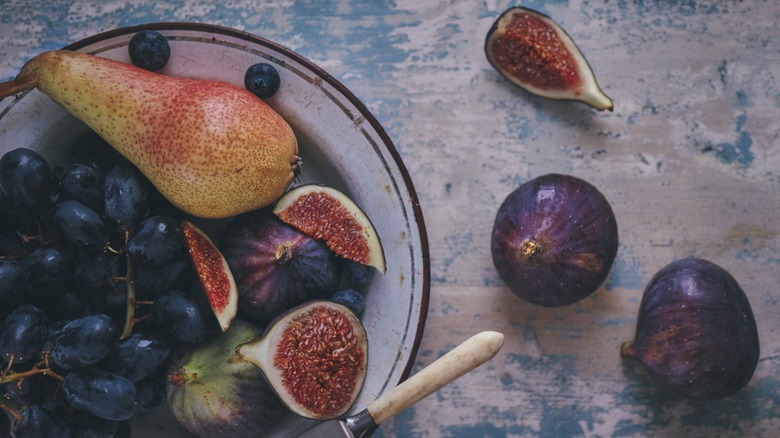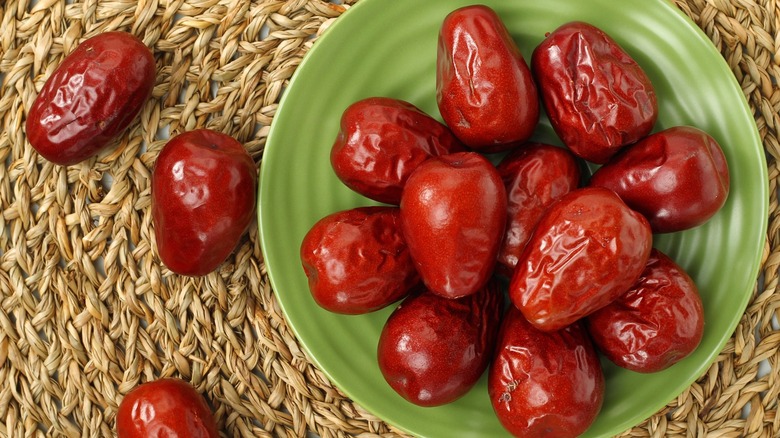The Oldest Fruit In The World Has Widely Been Up For Debate
Forget the paleo diet. Today, we're looking back much, much further into the human dietary habits of the past. During the British Antarctic Expedition of 1910 to 1913, British explorer Robert Falcon Scott left behind a fruitcake, which was frozen solid and found by other explorers over a century later in 2017. But, for as momentous as a discarded fruitcake may be, scientists have been busy digging up the earliest evidence of human cooking, crop cultivation, and food consumption in general for decades. And it seems like the more discoveries are made, the more complicated the question of what came first becomes. So, what is the oldest fruit in the world?
While determining a specific answer has emerged as a point of juicy contention (pun intended), historians agree that the diet of most ancient cultures primarily consisted of fruits and vegetables (proto-vegetarians, rise up). Hunting activities like spearing wild boar and catching fish required tools and techniques that had yet to be invented. Before that, eating was all about gathering. The ancient Romans were dining on figs, dates, pears, and grapes around 200 B.C. But early fruit baskets weren't always such a lush, diversified cornucopia. Let's take a look at the history of some of the earliest fruits on foodies' crave lists, going backward.
Apples and bananas (1,445 B.C. to 600 B.C.)
A popular candidate for the world's first fruit seems to be the banana. Bananas originated at least 10,000 years ago in what is today Indonesia and the surrounding regions. They're mentioned in multiple Greek, Latin, and Arab writings and in the Buddhist Pali Canon of 600 B.C. Alexander the Great even wrote about seeing bananas during an expedition to India in 327 B.C. But, despite what you might have covered in history class, the practice of eating fruit is a lot older than that.
The proverbial "forbidden fruit" of Christian Biblical times seems like an obvious contender for the world's first. Bible scholars estimate that the book of Genesis was written between 1,445 B.C. and 1,290 B.C., which would make apples at least 3,000 years old. However, some earlier translations of the text designated the forbidden fruit not as an apple but as a citron. Many paintings from the Medieval era depict the ejection from the Garden of Eden and show Eve holding a citron.
Citrons are also one of the Four Species mentioned in the Jewish observance of Sukkot following Yom Kippur and the fruit is mentioned in Hindu religious texts dating back to 800 B.C. In ancient times, the citron was more valued for its fragrance than its bitter, largely inedible flesh and thick rind. Over time, the lemon-like fruit evolved into other modern citrus varieties, highlighting the differences between citrons and lemons. And that's only the beginning.
Pears and pomegranates (5,000 B.C. to 3,500 B.C.)
Jump backward another 2,700 years and the foodies of ancient Egypt were digging into pears. A team of French researchers examined the bones, teeth, and hair of mummies that had lived in Egypt between 3,500 B.C. and the year 600. Per their study, which was published in the Journal of Archaeological Science in 2014, the researchers were able to discern that the ancient Egyptians were likely eating pears based on the high concentration of carbon derived from C3 plant material found in the mummies' bones and tissues. But, as hard as it may be to believe, even these mummies had ancestors, and those ancestors were likely eating other, even older fruits.
Pomegranates date back to the Bronze Age (5,000 to 3,000 B.C.) and appear in both the Quran and the Bible. Pomegranates also play a key role in the ancient Greek myth of Persephone and Hades, which would place the fruit in the hands of foodies as early as 1,200 B.C. With its magenta hue and trypophobia-triggering texture, this fruit just looks like a primordial relic. Still, this isn't its earliest mention in writing. The Hindu Rigveda and Atharvaveda consider the pomegranate to be a symbol of prosperity and blessing, associated with the deities Ganesha and Lakshmi. Considering that the Rigveda is the oldest of the sacred Hindu texts, that means pomegranates were a common dietary fixture by at least 1,500 B.C.
Figs and grapes (6,000 B.C. to 5,000 B.C.)
A whopping 3,500 years before folks started writing about pomegranates, they were digging the fig. Figs originated in Asiatic Turkey and the Mediterranean region where they were one of the earliest fruit trees to ever be cultivated by humans. Figs appear in the Old Testament of the Bible and farming records show that figs were regularly produced around the Aegean Sea. The Olympians of ancient Sparta ate figs as did Pliny the Elder and the prophet Mohammed. Even still, grapes might have come first. One of the earliest culinary innovations in human history is wine, which necessitates a thorough understanding of the domestication and handling of grapes.
According to a 2017 study published in PNAS, archaeologists uncovered pottery shards in the transcontinental country of Georgia (spanning parts of Europe and West Asia) that show evidence of winemaking tracing back to 6,000 B.C. According to the study, the clay had absorbed traces of grape pollen and citric acid, meaning ancient Georgian foodies were working with grape wine. For reference, in the 6th Millennium B.C., the first ancient Egyptians were just moving into the Nile River Valley, and ancient Middle Eastern cuneiform still wouldn't be invented for another 2,800 years.
One fruit pre-dates them all
Before grapes it was dates. In fact, before every other fruit, it seems like dates were there. The jujube, aka the Chinese date, is one of the oldest known cultivated fruits in global history, dating back to the Neolithic Age, which began in roughly 10,000 B.C. For reference, the Neolithic era is also referred to as the "New Stone Age," and it's the point in human history when people first started making stone tools, learning how to raise livestock, and planting crops. The jujube originates from the middle and lower river basins of China's Yellow River but its popularity has spread to at least 48 countries, stretching from South Korea to Iran, the United States, Italy, Australia, and more.
Still, according to a 2017 study published in Science, archaeologists in South America uncovered an even older fossilized fruit that traces back 52 million years — long before humans walked the Earth. This ancient fruit is closely related to tomatillos and ground cherries and belongs to a class of berries that has evolved into more than 2,000 modern species including peppers, potatoes, and tomatoes.
As our delicious deep-dive comes to a close, it's worth mentioning that scientists and historians are still debating which fruit (exactly) pre-dates the rest of them. Findings are inconclusive, but one thing is for sure: Among the unexpected facts about ancient peoples' eating habits is that for as long as we've been chewing and swallowing, a little fruitiness never hurt anybody.




